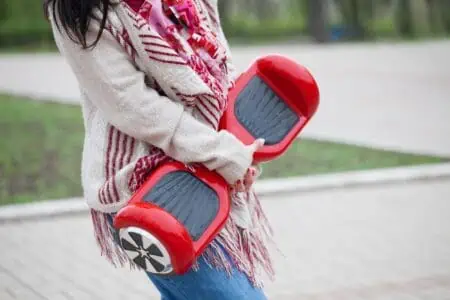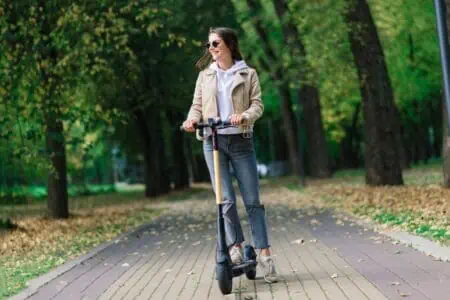If the headlines about hoverboard recalls have you worried, you aren’t alone. Since 2016, we have seen nearly a million recalls due to fire hazards and injury risks. It pays to be careful.
I’ve dug into the history of these recalls to find out exactly which brands dropped the ball, why these gadgets catch fire, and the big question: are they safe now?
You need this info before you buy a new hoverboard or dust off that old one in the garage. A quick check now could save you from a serious accident later.
Hoverboard Recalls From 2016 to 2023
There have been over 900,000 hoverboard recalls since 2016. Major incidents include:
- Hoverboard LLC Powerboard: 70,000 units recalled due to fire risk.
- Keenford iMotor: 84,000 units recalled due to fire risk.
- Swagway LLC Swagway X1: 267,000 units recalled due to fire risk.
- iLive Select Models: 8,700 units recalled.
- Jetson Rogue Hoverboard: 53,000 units recalled.
A Rocky Start: History of Hoverboard Recalls
Hoverboards hit the mass market in 2013, but they didn’t truly explode in popularity until 2015. Unfortunately, “explode” is the operative word here.
Shortly after they became the must-have holiday gift, disaster struck. Reports flooded in that the lithium-ion batteries powering these self-balancing scooters were overheating and catching fire.
By 2017, the Consumer Product Safety Commission (CPSC) reported over $4 million in property damages (1). Between 2015 and 2017 alone, there were 250 confirmed cases of overheating or fire. These weren’t just small sparks; they led to smoke inhalation injuries and significant property loss.
The situation got so bad that in 2016, half a million units were recalled (2). This massive wave affected brands like Sonic Smart Wheels, LayZ Board, and iHoverspeed.
Amazon took the unprecedented step of offering full refunds to anyone who had purchased a hoverboard through their site (3).
While the industry has cleaned up its act significantly, risks remain. In April 2022, a tragic fire linked to a Jetson hoverboard claimed two lives (4). That specific incident triggered a recall of over 53,000 units in 2023.
Safety Tip
Always verify that your hoverboard is UL-certified. While most use lithium-ion batteries, some brands now use Lithium Iron Phosphate (LiFePo) batteries, which are chemically more stable and less likely to combust.
The Science of the Spark: Why They Explode
It sounds like a movie plot, but hoverboards really can explode. The culprit is almost always the lithium-ion battery pack. Here are the four primary triggers for these fires:
- Internal damage: Short-circuiting or torn wires inside the chassis.
- Manufacturing defects: Poor soldering or cheap wiring components.
- Thermal runaway: Batteries overheating during use.
- Charging failures: Overcharging the battery cells, leading to combustion.
The science is simple but scary. The liquid electrolyte inside a standard lithium-ion battery is highly flammable. If the thin separator between the anode and cathode breaches (due to a crash, puncture, or manufacturing defect), it creates a short circuit. This heats the liquid rapidly, causing it to expand and eventually explode.
Cheap, unregulated batteries were the main problem during the initial craze, leading to the strict regulations we see today.
Are They Safe to Ride Today?
Safety depends heavily on the precautions you take. While UL-2272 certification has made modern boards much safer, it does not make them invincible.
The data is sobering: at least 19 people died from hoverboard fires in 2022, and emergency rooms treated dozens of burn injuries (5).
You can mitigate these risks. Never charge your board overnight or when you aren’t home. Keep it in a ventilated area, away from flammable items like curtains or couches. If it starts to smoke or hiss, you need to be there to act immediately.
Beyond fire, gravity is still an enemy. Falling off a hoverboard is common. You should treat it like a bike or skateboard: wear a helmet, wrist guards, and knee pads every time you step on.
The bottom line? Hoverboards are safer than they were in 2015, but they are not risk-free.
Understanding UL Certification
If you take one thing from this article, let it be this: never buy a hoverboard without a UL 2272 certification.
Underwriters Laboratories (UL) stepped in during 2016 to create a safety standard. The UL 2272 protocol rigorously tests the electrical and mechanical systems of the board. They aren’t just looking at how well it rides; they are trying to destroy it to ensure it fails safely.
The testing gauntlet includes:
- Drop tests: Dropping the unit from one meter to check battery integrity.
- Jam tests: Locking the wheels to see if the motor overheats.
- Puncture tests: Piercing the battery cells.
- Endurance runs: Running the unit for seven hours straight.
If a board overheats, sparks, or smokes during these tests, it fails. The CPSC considers any non-certified board to be defective and dangerous.
Beware Of Fakes
Unscrupulous sellers may slap a fake sticker on a box. A genuine UL holographic label will have the UL logo in a circle, the word “LISTED,” and a specific control number you can verify (6).
Comprehensive Recall List
About 500,000 units were pulled from shelves in 2016 alone. Below is a breakdown of major recalls reported by the CPSC from July 2016 through 2023 (7).
| Brand | Date | Product | Reason | Units |
| Hoverboard LLC | July 6, 2016 | Powerboard hoverboards | Risk of fire | 70,000 |
| Yuka Clothing | July 6, 2016 | Wheeli, 2 Wheelz, Back to the Future, Mobile Tech, Hover Shark, NWS, X Glider, and X Rider self-balancing scooters | Risk of fire | 800 |
| Hype Wireless | July 6, 2016 | Hype Roam hoverboards | Risk of fire | 25,000 |
| Boscov | July 6, 2016 | Orbit hoverboard | Risk of fire | 1,300 |
| Razor | July 6, 2016 | Hovertrax hoverboards | Risk of fire | 28,000 |
| Digital Gadgets | July 6, 2016 | Hover-Way hoverboard | Risk of fire | 16,000 |
| PTX Performance Products | July 6, 2016 | Airwalk hoverboard | Risk of fire | 4,900 |
| Keenford | July 6, 2016 | iMoto hoverboard | Risk of fire | 84,000 |
| Swagway LLC | July 6, 2016 | Swagway X1 | Risk of fire | 267,000 |
| Overstock.com | July 6, 2016 | Various products | Risk of fire | 4,300 |
| World Trading | December 13, 2016 | Orbit hoverboards | Risk of fire | 1,900 |
| iRover | July 24, 2017 | iRover model 87645 and 87644 | Risk of fire | 2,800 |
| Go Wheels | November 14, 2017 | All Go Wheels hoverboards | Risk of fire | 1,800 |
| Sonic Smart | November 14, 2017 | Sonic Smart model number S-01 or SBW666SL | Risk of fire | 1,000 |
| Tech Drift | November 14, 2017 | Tech Draft hoverboards | Risk of fire | 100 |
| Drone Nerds | November 14, 2017 | Some Drone Nerds hoverboards | Risk of fire | 700 |
| iLive | November 14, 2017 | iLive models GSB56BC, GSB56RC, GSB65BUC, GSB56WC and GSB56GDC | Risk of fire | 8,700 |
| iHoverspeed | November 14, 2017 | All iHoverspeed | Risk of fire | 900 |
| Smart Balance | November 14, 2017 | Smart Balance Wheel hoverboards | Risk of fire | 700 |
| Razor USA | August 25, 2021 | Removable GLW battery packs in Hovertrax 2.0 | Risk of fire | 237,000 |
| DGL Group | May 19, 2022 | Hover-1 Superfly model H1-SPFY | Risk of fall and injury | 93,000 |
| Jetson | March 20, 2023 | 42-volt Jetson Rogue Hoverboard | Risk of fire | 53,000 |
If you are worried about your specific model, verify it on the CPSC website. Type in your brand name plus “hoverboard” in the search bar.
If your brand appears, check the specific model numbers. A recall doesn’t always cover every single unit a company ever made. However, if your model is listed, stop using it immediately. The CPSC page will guide you on how to get a repair, replacement, or refund.
10 Steps to Safer Riding
Hoverboards have a reputation for being dangerous, but you can manage the risk. If you are determined to ride, follow these ten rules to stay safe:
- Store it correctly: Keep the board in a cool, ventilated spot. Let it cool down after a ride before you plug it in to charge.
- Supervise kids: Adults need to watch kids actively. Put the phone down and keep eyes on the rider.
- Wear safety gear: This is non-negotiable. Wear a helmet, knee and elbow pads, and wrist guards. They are the difference between a bruise and a fracture.
- Monitor the charge: Never leave the device charging unattended. If it overheats, you need to be there to handle it. Do not charge it while you sleep.
- Know the law: Check your local ordinances. Many cities ban hoverboards in public spaces like malls, airports, or even sidewalks.
- Buy quality brands: Skip the cheap knock-offs. Stick to reputable names like Swagtron or Segway that adhere to safety standards.
- Stick to smooth ground: Cracks, bumps, and gravel are your enemies. Stick to smooth pavement or indoor floors to prevent sudden falls.
- Verify UL 2272: Ensure the packaging and the unit itself bear the UL holographic seal. If it doesn’t have it, don’t ride it.
- Practice patience: You won’t be a pro in five minutes. Take your time learning to balance before you try to go fast.
- Ride in the light: Avoid night riding. Even with LED lights, you are small and hard for cars to see.
Other Safety Concerns
Fire isn’t the only risk factor here. The mechanics of a self-balancing scooter naturally lead to falls.
Between 2017 and 2021, the CPSC noted over 77,000 injuries involving micro-mobility devices like hoverboards and e-scooters (8). While e-scooters make up a large chunk of that data, hoverboards contribute significantly to fractures, sprains, and bruises.
Adults are actually three times more likely to suffer facial fractures than children, likely due to height and center of gravity.
Also, be aware of traffic risks. In some states, these boards are street-legal. I personally think riding a hoverboard alongside cars is a recipe for disaster, so I highly recommend sticking to parks or driveways.
FAQs
Recapping the Recalls
The hoverboard saga has been dramatic. We’ve seen nearly a million recalls since 2016, with 93,000 occuring just recently due to fall risks. While engineering has improved and UL testing has raised the bar, the danger hasn’t disappeared entirely.
Fires, injuries, and fatalities still happen. If you decide to buy one, look for the UL 2272 seal, buy from a trusted brand, and never let your guard down regarding charging safety.
Hoverboards are fun, but they require respect. Ride smart and stay safe.










